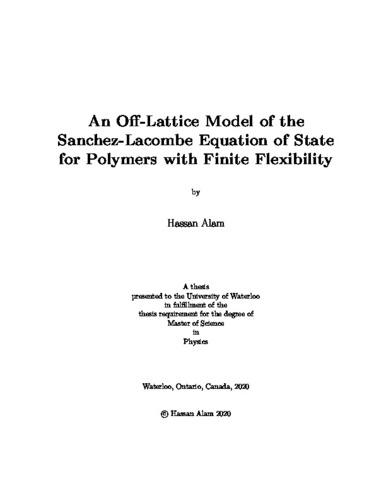| dc.contributor.author | Alam, Hassan | |
| dc.date.accessioned | 2020-05-19 20:13:02 (GMT) | |
| dc.date.available | 2020-05-19 20:13:02 (GMT) | |
| dc.date.issued | 2020-05-19 | |
| dc.date.submitted | 2020-05-04 | |
| dc.identifier.uri | http://hdl.handle.net/10012/15889 | |
| dc.description.abstract | An extension to the off-lattice Sanchez Lacombe equation of state is proposed by including internal degrees of freedom to account for the finite flexibility of polymer molecules. The extension allows polymer molecules to have two energy levels of flexing, a ground/unflexed state and a degenerate excited/flexed state. The finite flexibility of polymer molecules is characterized by two regression parameters, the energy of excited states and their degeneracy. The flexibility parameters are regressed by using two experimental values: the glass transition temperature of pure polymers at atmospheric pressure and the change in isobaric heat capacity of pure polymers across the glass transition at atmospheric pressure. A method has been outlined to regress these parameters from experimental data.
The glass transition temperature versus pressure and the isobaric heat capacity versus temperature predictions of the off-lattice model are compared with a lattice-based model from the literature. The lattice-based model is based on the Gibbs DiMarzio criterion which says that, at the glass transition, the configurational entropy of polymers becomes zero. However, the proposed off-lattice model shows that the Gibbs DiMarzio criterion is a consequence of the artificial lattice. Thus a new criterion is introduced which says that the glass transition occurs at a particular fraction of maximum polymer entropy that also minimizes the degeneracy of the excited state. Experimental data of several pure polymers are utilized to compare the predictions of both models. The proposed off-lattice model is found to be more accurate than the lattice-based model.
The model is also employed to predict the glass transition temperature versus pressure behaviour of binary polystyrene/CO2, polycarbonate/CO2 and poly(methyl methacrylate) mixtures. Experimental solubility data is used to regress the binary interaction parameters of the system. The model predicts that the binary polystyrene/CO2 mixture shows depression in glass transition temperature with the increasing pressure of CO2. The prediction is in agreement with the experimental observations and is superior to the lattice-based model. However, for binary polycarbonate/CO2 and poly(methyl methacrylate)/CO2 mixtures that undergo retrograde vitrification, predictions for the present theory are not correct because underlying inconsistencies in the model make regressed values of binary interaction parameters less accurate. Nonetheless, using hand-picked values of binary interaction parameters, retrograde vitrification trend can be obtained. | en |
| dc.language.iso | en | en |
| dc.publisher | University of Waterloo | en |
| dc.subject | glass transition | en |
| dc.subject | polymeric foams | en |
| dc.subject | polymers | en |
| dc.subject | off-lattice | en |
| dc.subject | Sanchez-Lacombe | en |
| dc.subject | equation of state | en |
| dc.subject | SL-EOS | en |
| dc.subject | retrograde vitrification | en |
| dc.title | An Off-Lattice Model of the Sanchez-Lacombe Equation of State for Polymers with Finite Flexibility | en |
| dc.type | Master Thesis | en |
| dc.pending | false | |
| uws-etd.degree.department | Physics and Astronomy | en |
| uws-etd.degree.discipline | Physics | en |
| uws-etd.degree.grantor | University of Waterloo | en |
| uws-etd.degree | Master of Science | en |
| uws.contributor.advisor | Thompson, Russell | |
| uws.contributor.advisor | Park, Chul | |
| uws.contributor.affiliation1 | Faculty of Science | en |
| uws.published.city | Waterloo | en |
| uws.published.country | Canada | en |
| uws.published.province | Ontario | en |
| uws.typeOfResource | Text | en |
| uws.peerReviewStatus | Unreviewed | en |
| uws.scholarLevel | Graduate | en |

